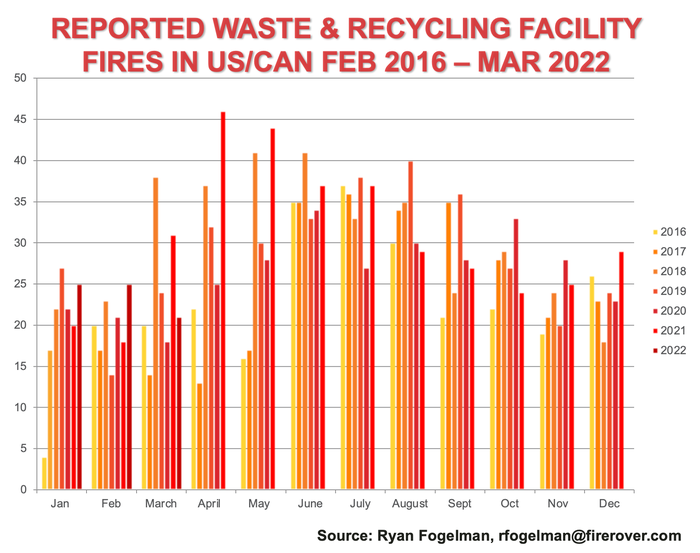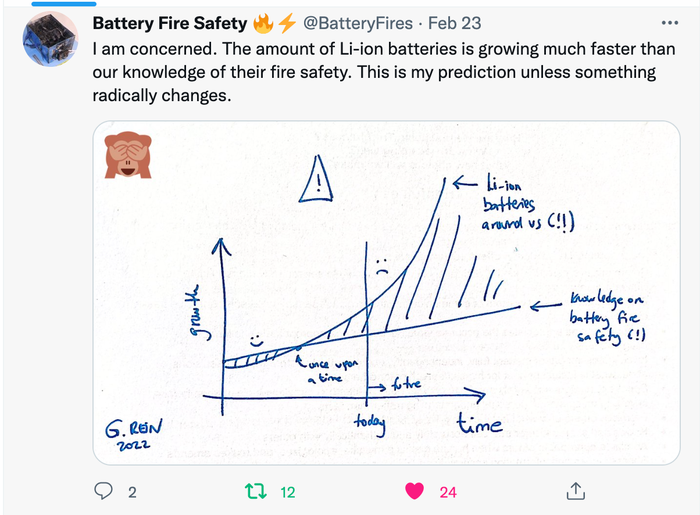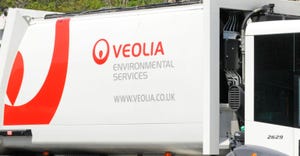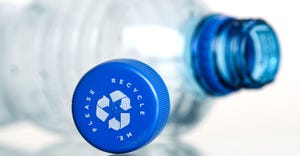What To Do When a Lithium-ion Battery Fire Starts at the Bottom of a Waste Pile
The waste and recycling industry continues to ride the rollercoaster wave of lithium-ion batteries, and the problem isn’t going away any time soon. We find these batteries at the top of waste piles, at the bottom of piles, in auto shredder residue piles, in equipment and more. So, what can we do to continue to fight these challenges?

The waste and recycling industry continues to ride the rollercoaster wave of lithium-ion batteries, and the problem isn’t going away any time soon. We find these batteries at the top of waste piles, at the bottom of piles, in auto shredder residue piles, in equipment and more. So, what can we do to continue to fight these challenges? Read on to learn more.
March 2022 Fire Data
In March 2022, we encountered 21 reported fire incidents at our waste and recycling facilities in the U.S. and Canada. Coming off the highest 12 months on record, March’s numbers are down from last year’s 31 and in line with the historical average. Of these reported incidents, nine occurred at waste, paper and plastic operations, eight at scrap metal facilities, two at organics sites and two at hazardous materials facilities. At Fire Rover’s 300-plus client operations, we responded to 67 events.

In 2018, the month of March really kicked off the lithium-ion battery fire incident wave that we experienced across the globe. Then in 2021, we saw March surpass 2018, with unexpectedly higher numbers. The point is that although the waste and recycling industry has tried to stem the tidal wave of lithium-ion batteries invading our waste stream, it is not time to let our guard down. As operators, we need to do more to ensure that we are working to limit the number of batteries that get into the supply chain, continue to hone and develop best operational practices for dealing with hazards once in the stream and look for long-term alternatives for mitigating these hazards.
How Do We Limit the Number of Batteries in Our Waste Streams?
The short answer is education and recycling. Education of the public is key to ensuring that we limit the number of batteries in our waste stream. However, even with education, it is not that simple. When it comes to getting batteries off the curb, we are dealing with two distinct issues: recycling bins and waste bins.
With the curbside recycling bin, we are facing the challenges of “wishcycling,” which is when consumers put an item into a recycling bin with the hope that it will become recycled. Sometimes, they are unsure if items are recyclable since the labels are confusing, and other times, they are unaware of what materials their recycling provider accepts. So, in the bin the materials go.
What consumers often don’t understand is that the curbside recycling bin is traditionally just for paper/cardboard, plastic/metal containers and, depending on your jurisdiction, glass. However, the good news is that over time, education can teach consumers to sort materials properly.
When dealing with the curbside trash bin, we are faced with a different issue altogether. I call it “the magic bin.” Whatever consumers throw away in the magic bin is taken by local trash haulers weekly, and then they get to start filling up the magic bin once again. Consumers throw away so many items that should never be thrown in those bins. For example, they throw away old electronics, paints, chemicals, aerosol cans, acids, fireworks, barbeque briquets and more. You name it, they toss it, and it is magically taken away with no consequences for this dangerous behavior. Inevitably, all these hazards end up causing fires in our materials recovery facilities (MRFs), transfer stations, landfills and trucks. These fires cause an estimated $2.5 billion in direct damages annually in the U.S. and Canada.
With all of this in mind, it’s important to point out that the real issue is that we as an industry do not make it easy for consumers to change their behavior. For example, we ask them to take their batteries to a drop-off point or mail them back to be recycled; we ask them to take their pool chemicals to a different drop-off point; and we ask them to keep these dangerous items segregated in their homes until they have enough product to make the trip worth it for them, potentially exposing them to further harm. The easy way to deal with this is to have the public segregate these harmful materials for the haulers to pick up, but that exposes the haulers to more risks and potential injuries. Not to mention the costs and unfair burden placed on our operators when they are already dealing with higher wage costs for employees, labor shortages, increased gas prices and more.
The fact is that lithium-ion batteries are not going anywhere soon. According to PS Market Research, the lithium-ion battery market generated $46,142.1 million in revenue worldwide in 2021. By 2030, this market size is forecasted to reach $165,847.8 million. These hazards are going to get into the waste and recycling streams. There is hope that robotic sorting will help remove some of these hazards from processing at MRFs, but even if these were 100 percent accurate today, which my contacts assure me they are not, it still leaves the trucks and tipping floors exposed to fire hazards.
Fire Protection Comes in Many Flavors
When it comes to fires, Professor Guillermo Rein, an engineer and professor of fire science at the Imperial College and editor at Fire Technology, is concerned for a different reason. Our fire professionals are not properly trained on the hazards that come from lithium-ion batteries. According to Andy Sterns, founder of Insight Fire Training, in the U.S. and Canada, we have 1.2 million firefighters. Of this number, almost 700,000 are volunteers. Less than 2 percent of our budgets are spent training our firefighters on all hazards, not just fighting lithium-ion battery fires. See Reins’ tweet from February 2022 below:

Our existing knowledge of fighting battery fires is not keeping pace with the hazards we are seeing. And that is just the firefighters. The burden falls back on the waste and recycling operators to train their staff on how to fight these fires, walk the fine line of developing a formal fire brigade and provide their local fire department with the tools, technology and equipment to properly fight these incidents once they inevitably do occur.
In 2018, globally as an industry, we were caught off guard by this new hazard of lithium-ion batteries, but now in 2022, most companies have a plan, which was evident in my conversations with attendees at the Institute of Scrap Recycling Industries’ show in Las Vegas. What I mean by that specifically is that as lithium-ion batteries have become commonplace in our operations, the focus on fire prevention is now in full effect. The question is, are these strategies enough to turn the trends we are seeing in the other direction?
One of the executives from a large scrap metal operator, whom I have a deep respect for, came by our booth and asked what the best solution is for finding the battery if it is on the bottom of a light tin pile. I am always asked what if this happens, or what if that happens, but the reality is that all fire incidents are unique, and there are different things that can happen. As humans we typically perceive dangers from our experiences. We are not afraid of little fires that are easily put out or controlled fires, but we are afraid of catastrophic fires that have large consequences.
My goal when talking to business owners, operators or executives is to make them experts on our solution by educating them on how our layers of protection that make up our firefighting framework can apply to any situation. But in my opinion, the hardest thing to do is to change perception. For example, some people focus on one factor that can cause a fire, like a lithium-ion battery in the bottom of a pile, when in actuality, fires can start many different ways.
Contrary to most people’s opinions, most fires occur during the daytime hours and on the surface. Our solution gets to these fires quickly, stopping the events from becoming major. Deep-seated fires can happen day or night, and they are harder to deal with, but we have fought all of these fires that start in an area we protect successfully with our solution.
At Fire Rover, we define fires that start at the bottom of a pile as deep-seated versus the alternative of a surface fire. Deep-seated lithium-ion battery fires are fought by soaking the hazard area and ensuring that once the battery has burnt through its fuel there is no other material that can burn, essentially breaking the chain and stopping the incident in its tracks. When attacking a deep-seated fire for our clients, our goal is to cool the entire pile if it is small enough. For larger piles, we pre-wet and pull away layers. We then continue this process until we get to the cause of the fire. In lieu of having the equipment onsite to remove the layers, we soak the material and intentionally spray the collateral assets so the fire stays contained until the fire department can arrive on scene. Our solution protects against this one factor and millions of other potential causes of fires but trying to educate while changing someone’s perception is probably the biggest factor we deal with.
If a company chooses to fight the fire with their employees, they must develop a strategy and train their staff to deal with these events when they do occur. One company’s solution for dealing with fire risks may be different from the path of another company. Which path is the correct one? Only time will tell, but at risk of using a cliché, the first step is admitting there is a problem and understanding there is an inherent risk of fire in our daily operations. The next step is trying to solve it and developing best practices that mitigate our risk to operations, employees and the public. The truth is that there are many solutions out there, and while any solution can work in theory, the question of its effectiveness is not truly known until “game time” when the fire protection layers are tested.
Our solution is tested across our 350-plus clients’ operations daily. We have learned from thousands of fire events, big and small, and we continue to learn new things each time we respond. Very rarely does the same event with the same circumstances occur twice in a lifetime, but having the framework, technology and response ready at a moment’s notice has provided a consistent track record that insurers can use to mitigate their risk of catastrophic losses in our occupancies.
Conclusion
Last month, I had the pleasure of attending several conferences. At the Southeast Recycling Conference, my colleague and 30-year veteran of the Detroit Fire Department Ron “The Jedi Master of Lithium-ion Batteries” Butler and myself presented on the hazards that lithium-ion batteries are causing both inside and outside of the waste and recycling stream. Butler’s presentation was especially interesting as he outlined the full story of the Morris, Ill., battery warehouse fire that occurred last year. He also discussed the lessons learned from the event including the fire department’s response criteria adjustment, redesign of fire control metrics and development of "flash" codes and their potential impact on battery recycling industries.
From a Fire Rover perspective, we deal with lithium-ion batteries hazards in our clients’ MRFs, transfer stations and scrap metal yards, and we protect some of the largest recyclers of electronics and electric vehicle batteries in the U.S. For example, we have a lithium-ion battery sprinkler replacement at a building less than 100 miles from the Morris, Ill., fire event where we have replaced the sprinklers with our Fire Rover early detection and fire elimination solution. The solution has several key distinctions, but most importantly, it’s that the fire department can take a defensive approach to fighting these fires by staying safely outside while our trained agents fight the fires on the inside. In these fires, our agents are not just fighting the fire directly, but they are indirectly coating the collateral assets with our environmentally friendly wetting agent in an effort to stop the domino effect that can occur once the initial pallet of batteries has burned itself out.
If you are heading to WasteExpo next month and would like to connect, come by the Fire Rover booth #3535 and introduce yourself. I am certainly looking forward to a great event!
Ryan Fogelman, JD/MBA, is vice president of strategic partnerships for Fire Rover. He is focused on bringing innovative safety solutions to market, and two of his solutions have won the distinguished Edison Innovation Award for Industrial Safety and Consumer Products. He has been compiling and publishing the “Reported Waste & Recycling Facility Fires In The US/CAN” since February 2016 and the “Waste & Recycling Facility Fires Annual Report.” Fogelman speaks regularly on the topic of the scope of fire problems facing the waste and recycling industries, detection solutions, proper fire planning and early-stage fire risk mitigation. Additionally, Fogelman is on the National Fire Protection Association’s Technical Committee for Hazard Materials. (Connect with Ryan on LinkedIn at https://www.linkedin.com/in/ryanjayfogelman or email at [email protected])
About the Author(s)
You May Also Like




